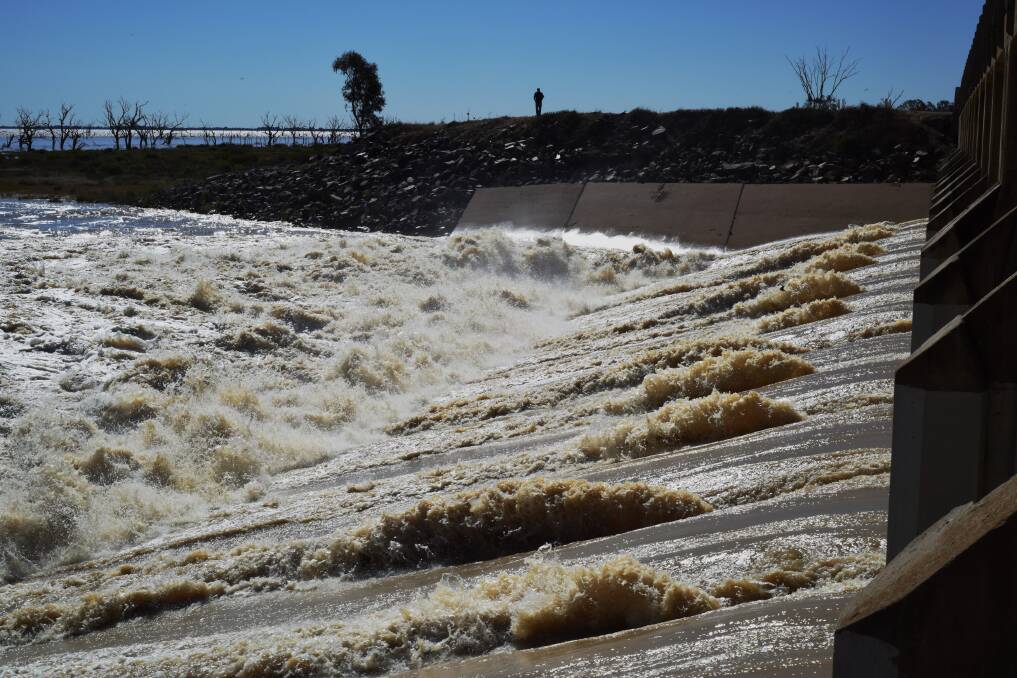
Lower Darling River residents have pointed the finger at the Murray Darling Basin Authority for releasing flood water from Menindee Lakes in 2017, arguing that had it been held back, there would have been fresh supplies to replenish the river
Create a free account to read this article
$0/
(min cost $0)
or signup to continue reading
River management data exclusive to this publication has revealed how floodwaters from 2016 where distributed down the Darling River.
Last week a mass fish kill event (see below for detail on how the event unfolded) occurred in an isolated pool in parched Darling River downstream of Menindee Lakes.
Locals have said water should have been held in storage to provide a fresh inflow of sweet water from Menindee Lakes, which would have provided a lifeline to suffocating fish.
An unusual winter flood in 2016 pumped into Menindee Lake, filling it to 94 per cent capacity. But by December 2017 most of that water had either dried up, or been released downstream.
The Barwon Darling, which feeds Menindee Lakes, is an interesting and challenging river system to manage.
Most of the water doesn’t it make it from the headwaters in Queensland into the water storages of Menindee Lakes.
Evaporation and seepage losses, and irrigation take (which averages 20pc of flows in the past 10 years) take their toll.
For example, in 2016, 7800 gigalitres of inflows flooded through the system and 1900GL made it into the lakes.
What are the Menindee Lakes?
The Menindee Lakes are a natural, ephemeral system which were engineered into a regulated water storage system in the 1960s.
At that time, interstate water sharing arrangements were put in place that mandated water sharing between NSW upstream and Victoria and South Australia downstream.
These arrangements are reflected in the current Basin Plan rules, which were put in place in 2012.
They state that when the volume of water in Menindee Lakes exceeds 640GL,a federal agency, the Murray Darling Basin Authority, manages the water releases for all jurisdictions.
The water is released to water downstream reaches of the river, provide a catalyst for native fish-breeding and to refresh the Lower Lakes in South Australia.
The MDBA retains control until there is less than 480GL in the lakes - which is considered a reserve amount and control reverts to NSW.
Who’s to blame?
Lower Darling River grazier Rob McBride said Menindee Lakes water was mismanaged, referring to the releases in 2017, and previous releases in 2014 which also occurred after heavy rain.
“We have to get to the bottom of who drained the lakes twice in four years,” Mr McBride said.
“We went eight-and-a-half months without water in the lakes in 2015 after they’d been drained, they miraculously filled again in 2016 and then they drained them again in 2017.”
RELATED READING
In mid-2016, as the lakes filled above the 640GL trigger, the MDBA took control.
The MDBA’s policy can be described as ‘use it or lose it’. High evaporation rates from Menindee Lakes are the guiding factor for its management regime.
“Unfortunately, it just makes most sense to use the water in the system that evaporates the most,” said MDBA chief executive Phillip Glyde.
“Menindee Lakes are very large and shallow. Between 20pc and 30pc will evaporate in a year and there’s no point in losing it.”
Mr Glyde said the decision to release the water was the right one, at the time.
“The difficulty is we have to make the decision without knowing what the weather will be.”
Breakdown of Menindee Lakes water releases
July to September 2016 - NSW controls Menindee Lakes
- 44GL to Lower Darling irrigators and for river flow
- 24GL for environment watering
- Evaporation losses 100GL
October 2016 to December 2017 - MDBA controls Menindee Lakes
- 45GL to water users on the anabranch of the Darling River
- 437GL to downstream irrigators on Darling and Murray
- 100GL to environment uses in the anabranch
- 120GL to Lower Darling environment
- Evaporation losses 600GL
December 2017 to January 2019 - NSW controls Menindee Lakes
- 47GL to Lower Darling Anabranch irrigators
- 83GL to Lower Darling irrigators
- Evaporation losses 300GL
Hypoxic fish kill
Blue-green algae flourished as daytime atmospheric temperatures reached above 40 degrees Celsius.
Then a sudden cold front came through, dropped around 15 millimetres of rain and the temperature by 15 degrees.
The sudden shift killed the algae and bacteria that break down algae went to work eating the dead organic matter and in the process chewed up the oxygen in the water, creating a hypoxic environment and effectively suffocating the fish stuck in the isolated river pools.
On average, about 4000 gigalitres flows into the Barwon Darling system from its tributaries.
But the Barwon Darling system received just 542GL in 2017-18 and Since July 2018 a paltry 30GL has flowed down the system.
Over the past 57 years, the Darling River has stopped running 57 times at Bourke - which is upstream of Menindee Lakes.


